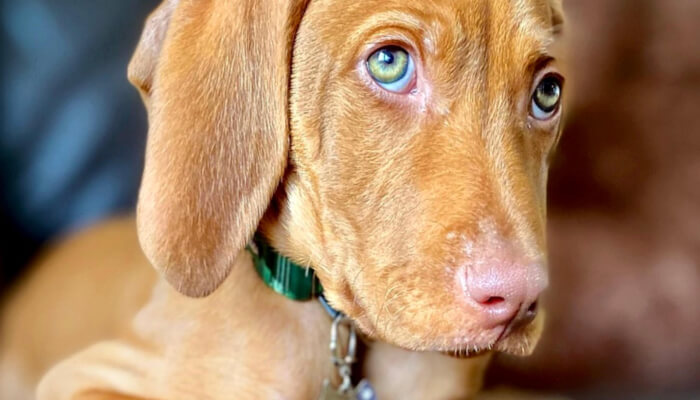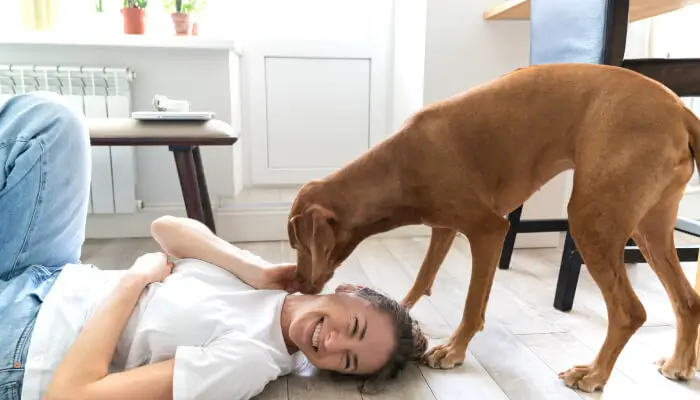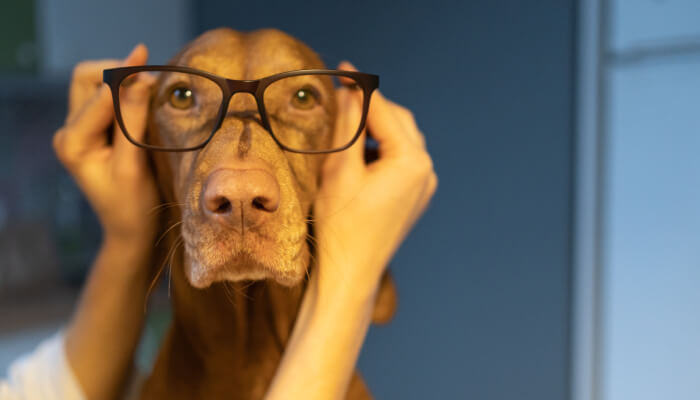Despite being a beautiful, intelligent, and friendly dog breed, Vizslas has their own flaws. And the most prominent one is their susceptibility to health issues from cancer, hip dysplasia, thyroid disorders to constipation, obesity, infection and now tear stain. So if your Vizsla has a pinkish stain around its nose, it could be the result of Vizsla Tear Stains.
Tear stains are not unusual in Vizsla. They may come from several different things, such as an abnormally large sebaceous gland on their face (which is most common), having light-colored fur showing the color of the tears, or being born with dark skin (even though they may change over time).
The good news is you don’t need to worry about these stains. This post will talk about what causes Vizsla Tear Stains and how to prevent them so you can keep your dog’s beautiful face clean and dry.
What Actually Are Tear Stain?
Tears cleanse our eyeballs’ surface and spread nutrients needed for life on both sides of optic nerve fibers in the contact lens membrane or retina at the back wall corner (anterior) of each eye. And this action is “lacrimation.” As we age, tears contain less water content which means they dry up faster than when we were younger. When the glands that produce tears overwork, they may not be able with our tear production. As a result, the build-up creates stains on Vizslas’ face.
How Does Vizsla Get Tear Stains?
Tears contain a lysozyme protein (an enzyme), which causes itchy eyes when we cry or have allergies. The lysozyme mixes in saliva, making it more difficult for Vizsla’s eyes to stay moist and without tearing. In addition, as Vizsla sheds fur around his neck, he creates a perfect environment for bacteria to grow. This leads him to bacterial infections such as conjunctivitis or “pink eye.” And the irritations can cause Vizslas’ eyes to water and become more susceptible to tear staining.
Vizslas have large, deep-set eyes which trap the dog’s tears and other fluids in them. Thus, Vizslas don’t just get small tear stains on their fur under their eye, but a lot of Vizslas will also develop a big round spot where they’re constantly rubbing their eyes on the ground.
What Are The Causes Of Tear Stains In Vizsla?
Usually, tear stains are present in the blocked tear duct of Vizsla. Vizslas produce tears to moisturize their eyes and clean them from dust particles that may enter the eye. Blockage of Vizsla’s tear duct or overproduction of tear leads to staining on the facial fur.
Moreover, the most common cause of tear stains in Vizslas are:
Poor Diet Cause Tear Stains In Vizsla
One Vizsla tear stains cause is a poor diet and too much stress. A Vizsla’s natural diet should consist of about 70% protein, 20% fat, and just under ten percent carbs. But that doesn’t mean they can never have anything else. Vizslas generally love fruits and vegetables as well (except for onions). Vizsla tear stains occur due to a poor diet you can resolve through balanced meals with good nutrition.
Stress Cause Tear Stains In Vizsla
Another Vizsla Tear Stains cause is too much stress. Vizslas are very active dogs and require lots of physical activity to stay healthy. But this doesn’t mean they should only go on walks around the block all day long. Vizslas need a lot of mental stimulation as well. Vizsla tear stains may be due to too much stress that you can resolve through short walks, playtime in the backyard, or playing fetch for a few minutes every day.
Allergies Cause Tear Stains In Vizsla
Vizslas have a fairly high number of allergies that can cause the production of excess tears. And because Vizslas do not like water on their faces, these tears pool in their eyes and make dark-colored spots or streaks, which owners assume as tear stains.
The Vizsla’s allergies might be due to many things, including dust and pollen from the outdoors, rubber or plastic flooring in their home, perfumes or colognes used on them, not to mention other dogs (especially Vizslas) who have these allergies and shed their hair or dander.
Irritant Environment Cause Tear Stains In Vizsla
Vizslas may be more prone to tear stains because the shape of their eyes makes them susceptible. A third eyelid protects the inner eye corner of Vizsla and shields the eye from irritants like dust and debris. Unfortunately, this leaves Vizslas’ eyes exposed to environmental factors that can lead to tearing staining.
Outdoor Vizslas with light-colored noses are more likely to experience tear stains because they can’t keep dirt and debris out as well.
Teething Cause Tear Stains In Vizsla Dogs
As Vizslas grow, they go through a teething process. This is when Vizsla’s teeth come in, and Vizsla’s gums become sore. Sometimes, this can lead to Vizsla tear stains because of the sores caused by Vizslas biting themselves due to pain or irritation on their mouth from new tooth growth. However, Vizsla tear stains usually go away after Vizslas have finished teething.
Eye Diseases Tear Stains In Vizsla Dogs
Vizsla is susceptible to several eye diseases like glaucoma, eye infection, conjunctivitis, entropion, or inward eyelashes.
Vizslas are prone to Entropion (also known as “pink-eye”), an eyelid condition that causes the lashes to grow inward and rub on the dog’s eye, eventually causing a buildup of gunky discharge or bits of hair around Vizslas eyes, which can cause stains. This is a common problem for Vizsla dogs, so Vizsla owners should be aware of it too.
Another possible culprit behind tear stain is conjunctivitis – inflammation in Vizisla’s eye lining caused by bacteria, virus, or fungi infection leading to watery eyes with pus drainage from the lids. Conjunctivitis may also produce thick, goopy, yellow discharge. Vizsla may also suffer from glaucoma, a chronic disease of the eye characterized by gradual loss of vision and eventual blindness that can be responsible for Vizslas tear stains.
Problems In Tear Duct Tear Stains In Vizsla Dogs
Tear ducts are an important part of Vizslas’ eye because they provide natural lubricant for Vizsla’s eyes. Vizsla tear stains are often due to a tear duct being unable to function properly. When your Vizslas eyelids close, the tears cannot flow as they should, and so instead of flowing into the nose through the nasolacrimal canal or out of the eyes, some will overflow onto their face. This darkening of skin cells then causes them to stick together and form what we know as a “tear stain.”
Do Vizsla Tear Stains Go Away?
Strange as it may seem, Vizsla tear stains are not due to crying. They get tear stains from the oils and other fluids they produce that leak out of their eyes or around their eyes. There is an enzyme in Vizslas- lysozyme which breaks down food particles into smaller molecules for easier digestion. This same chemical also helps to break down bacteria on surfaces like our skin and fur. As a dog produces this fluid, some of it leaks out through his eyelids or moistens the hair close to the eye area, causing those tell-tale dark rings around your Vizlsala’s eyes (called “tear staining.”)
They typically will go away naturally after about six months. The crying triggers an inflammatory response that causes more oil production from sebaceous glands near the nose, blocking pores and making them darker. After six months, the Vizsla’s sebaceous glands will stop producing oil, and the tear stains should disappear.
Can You Remove Vizsla Tear Stains?
Vizslas have the potential to get tear stains which can be due to many factors. So if you’re wondering how to remove Vizsla tear stains, well, there are actually two ways that work quite effectively.
And thus, the ways to remove Vizsla’s tear stains are:
- Clean the Vizsla’s face after every meal (or as often as needed)
- Use a damp cloth to pat Vizsla’s cheeks and eyebrows, then wipe clean with a dry towel
- Apply eyewash or an over-the-counter artificial tear solution to Vizsla’s eyes
- Apply a topical product with vitamin A and zinc oxide to Vizsla’s face (doggy eye ointment)
- Give Vizsla a topical antibiotic ointment to use as needed
- Keep Vizsla out of the sun
How Do I Get Rid Of My Vizsla Tear Stains?
Most Vizsla owners are not aware that Vizslas have unusually high tear-producing rates. It means Vizslas produce an excessive amount of tears. And this can lead to Vizsla tear stains in the fur around their eyes, particularly on the upper eyelid and near the nose. These stains tend to be yellowish or brownish and may look like dried dairy products if they get terrible.
But luckily, there are some ways to get rid of your Vizla tear stain. Such as:
- Use a damp cloth to gently wipe Vizsla’s face to remove the Vizsla tear stains.
- Use a pet-specific shampoo to wash Vizsla’s face, and then use a towel or cloth to dry Vizslas’ fur before it dries on its own.
- Cover Vizslas eyes with Vaseline each night until the Vizsla Tear Stains disappear.
- Apply human eye ointment over Vizslas’ upper eyelid for 30 seconds at bedtime, which may help stop tearing.
- Give Vizsla ice cubes made of water to the freezer for at least two hours to soothe their eyes.
- Clean Vizsla regularly with an eye cleansing solution specially designed for Vizslas.
- Bathe Vizsla in medicated shampoo with tear stain remover.
- Visit the Vet to determine if Vizsla has an eye infection.
How To Prevent Vizslas From Getting Tear Stains?
Many Vizslas experience problems with tearing due to an inability to produce enough natural lubricant. As a result, their tears drain from one side of their eye socket down into either nostril, where they can feel difficulty breathing. So, it is crucial to prevent Vizslas from getting tear stains.
So, the best ways to prevent tear stains in Vizsla are:
Don’t Leave Your Vizsla In Heat For To Long
Vizslas are seasonal shedders, but they can also produce excessive amounts of tears during the heat. As a result, it’s not unusual for your Vizsla to have wet eyes when you get home from work every day in the height of summer. After long exposure to the sun, they will be unable to control their own eye fluid production.
Thus, it flows out unannounced and causes tear stains. However, you can control this by giving your dog fresh and clean water as soon as you reach home.
Always Fill Your Vizsla’s Bowl With Fresh Water
A Vizsla’s tear stains might be due to the buildup of bacteria and debris that lodges in the eyes. A Vizsla should always have an adequate supply of freshwater available to keep them from having tear stains. So, Vizslas need plenty of cool, fresh drinking water at all times, or they will get tears staining on their face. It’s a common problem for long-haired breeds like Vizslas during hot months because they produce more eye fluid than normal.
It also prevents other health problems associated with dehydration, such as vomiting, diarrhea, and lethargy.
Use Lubricant To Prevent Tear Stains In Vizsla
Vizsla owners can help keep the eye moist by using an ophthalmic lubricant or a cold compress on them every day. They might also get special tear-duct treatments from specialists like at their vet’s office. However, it is usually successful if you repeatedly and consistently use lubricants. Also, take them for treatment over an extended period of time.
Proper Grooming To Prevent Tear Stains In Vizsla
Daily brushing and combing should be part of Vizsla’s grooming routine. Be sure to get all the way down to his skin and remove any debris or dirt that might have found its way on him during a walk, run, playtime, etc.
Brushing your Vizsla regularly also means you will notice when he starts itching himself excessively due to flea irritation or allergies (see our other blog post about Vizslas with Allergies). Further, bathing your Vizsla with medicated shampoo or a gentle oatmeal shampoo can help alleviate Vizsla’s skin irritations.
Thus, this step is crucial if you want to avoid Vizsla tear stains.
Keep Your Vizsla’s Eyes Clean and Clear
Vizslas typically have watery eyes, which means they are more prone to tearing up when the weather changes or playing card games. Make sure his face stays clean by wiping it with a damp cloth after being outside for a long time or playing excessively before bedtime.
This will keep any irritants away from your Vizsla’s sensitive eye tissues, thus reducing the chances of Vizsla Tear Stains on their faces.
Monitor Your Vizsla’s Diet
Vizsla tear stains may be due to obesity, which is why keeping tabs on your Vizlsa’s nutritional habits is important. Feeding them high-calorie foods or fatty treats in excess will cause Vizslas to gain weight and tear up more often. Instead, you should monitor the diet and provide plenty of exercise by playing with other Vizslas (or another type of dog).
Some types of food that may increase the likelihood for Vizsla Tear Stains include broccoli, spinach, onions, garlic, etc. Avoid these ingredients if your Vizsla is allergic, or they have chronic tears due to them. If not, you need to cook these vegetables thoroughly and give them as small servings not to irritate Vizsla’s eyes any further.
Sufficient Exercise To Prevent Tear Stains In Vizsla
Vizslas are energetic and playful dogs. So, exercise is essential to prevent tear stains in Vizsla. Why? Exercise helps build up a dog’s immune system, releases pent-up energy, and releases serotonin, the happy hormone. As a result, Vizslas with a healthy amount of exercise are less likely to develop tear stains. It is because they don’t have excess mucus in their bodies. And also, due to a sluggish immune system or too much pent-up anxiety, which can cause them to cry more often.
Conclusion
Summing up, Vizsla’s usually do develop tears on their faces over time which may leave those unsightly brownish red marks all around your Vizsla’s head area that we call “Tears Stains.” Luckily, Vizsla tends to get these “Tears” mainly located in the same areas of their head, making it easier to keep up with Vizsla tear stains.
We hope this article gave you insight into how Vizsla gets tear stains and what you can do to prevent them. If your dog is experiencing excessive tearing or any other eye condition such as dry eyes, it is best to seek help from a veterinary ophthalmologist. We would also love to help answer any questions you may have about our tear stains.



